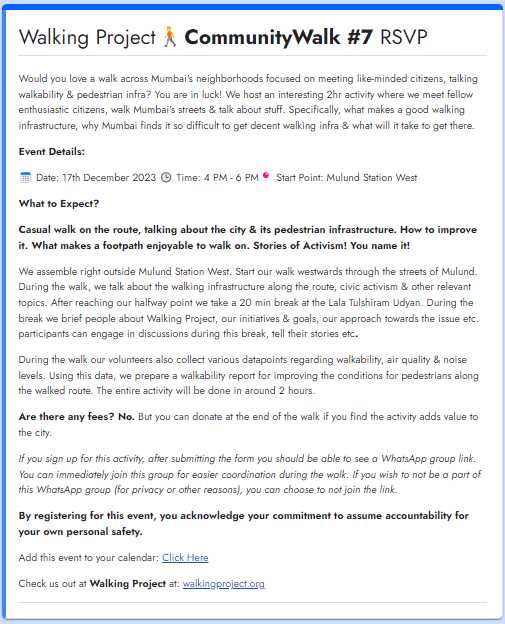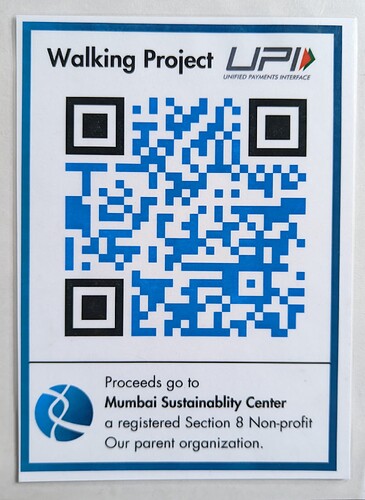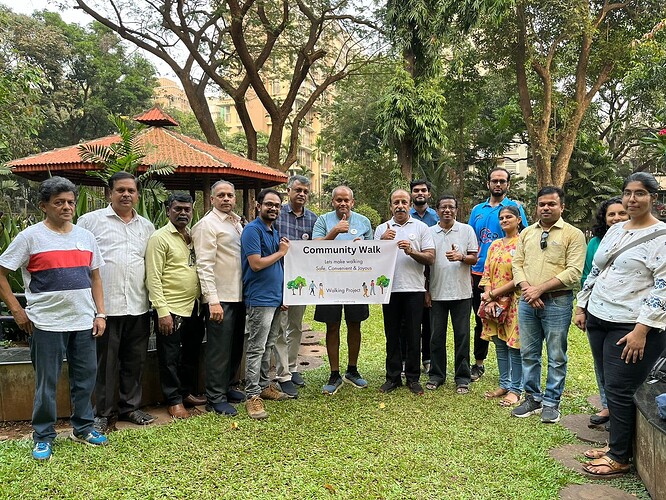About the author: Walking Project is a grass roots pedestrian advocacy organization currently operating in the Mumbai Metropolitan Region.
Indian cities are known to have terrible walking environments, most of us tend to walk and endure these places everyday. But what if you wanted to mobilize the community, bring together the locals for a citizen-led activity to map the walking conditions, prepare a report & send it to your local municipality with recommendations for improvements? We have a plan for that. Over the past 4 months, we have conducted 7 such walks across different neighborhoods of Mumbai. Brought together citizens, and learnt a thing or two about hosting successful walks. In this thread, we will list down our methods & tips to host a successful Community Walk.
Prerequisites
Before planning a walk, it’s essential that, as the host, you have a good understanding of the official guidelines regarding walking and road infrastructure. This enables you to identify inconsistencies and issues within the existing walking environment during your walk. Presently, the ‘Indian Roads Congress,’ a government body, is responsible for establishing these guidelines. The document IRC 103 serves as a resource to learn about them. We have uploaded its link on our website: IRC103(2012).pdf
Identifying a route
Before settling on a route, it is important to keep a few things in mind.
Accessibility Matters: Whatever route you plan, ensure it is easily accessible for the target audience to reach, Routes near major transit stops usually tend to have a good response, as they naturally draw more attention due to convenience.
Choose a Popular Route: Opt for a route that sees significant foot traffic daily, such as those leading to major transit hubs like bus depots, metro stations, or rail stations. The interest in mapping or fixing a route directly corresponds to the number of daily users. This and the previous point are closely related.
Add Variation: Prevent monotony by incorporating small diversions along the route. Interaction with major intersections keeps participants on their feet, engaged and interested in the walk.
Plan Breaks: Integrate rest periods into the route, preferably at a local park/garden. The walk’s structure should allow for rest stops, ensuring participants can take a breather & you have a mid-walk section where you can brief people regarding the goals of the walk.
Consider Length: Keep the walk to an appropriate length, as per our experience, around 2 kilometers can be covered comfortably within 2 hours. Longer walks might lead to waning interest, especially since this activity isn’t inherently a fun or entertaining one unlike heritage walks.
Preparing brochures and pamphlets
Once you have narrowed down on a route, the next step is to make the event details public. flyers & e-flyers are a good choice as these can be both shared online as well as handed out to people in person. There are several free online tools you can make use of to prepare attractive flyers.
Canva & Adobe Express can be used for preparing flyers.
Google MyMaps is a good platform for creating routes on a map which are shareable to the people. You can screenshot the created map to use in your flyer.
This is what a generic Community Walk flier for Walking Project looks like. Pay close attention to the placement of the words and elements. Each of these are placed for a reason :wink:
Preparing & sharing a RSVP form
Implementing an online RSVP form for your event is a fundamental step to ensure clarity on attendee numbers, resource planning, and managing the expected crowd. This practice not only provides insight into who will be present and how many attendees to expect but also sets clear expectations for potential participants before they commit to attending.
Moreover, utilizing a form allows for control over participant numbers, a crucial aspect to maintain a conducive interaction environment. A general guideline suggests that one individual can effectively engage with a maximum of 7 people. Exceeding this limit might result in some feeling overwhelmed or excluded, impacting long-term engagement with the project adversely.
Below is an example of one of our RSVP forms
Additionally, in your response forms, consider requesting attendees to share their mobile numbers. This information can facilitate the creation of a coordination group on messenger apps, streamlining communication and enhancing overall event management.
The link to the form can be widely distributed across various social media and communication platforms. It’s versatile enough to accompany event flyers or be shared alongside a thoughtfully crafted, personalized message to potential participants. This multi-channel approach ensures maximum visibility and accessibility, increasing the likelihood of receiving responses and engaging a diverse audience.
Gearing up for the walk event
Material Preparation:
Ensure all necessary materials for the walk event are gathered at least a day in advance. This could be anything; banner for photo opportunity, badge/brooch, notepad, portable speaker. Depending on what all activities you want to add to the event.
WhatsApp Group Creation:
Create a temporary WhatsApp group for live location sharing and real-time coordination during the walk.
Pre-Walk Notifications:
Notify participants about the:
- Exact meeting point with a picture and Google Maps pin.
- Expected weather conditions.
- Any local public transport disruptions or advisories.
- A gentle reminder for individuals requiring prescription meds to bring them along.
Detailed Itinerary:
Prepare a detailed itinerary for the walk to cover all key points and planned activity preferably in a to-do list format.
Equipment Preparation:
Bring necessary equipment such as:
- Cameras or notepads for documentation.
- Ensure devices like mobile phones or tablets are fully charged for displaying pictures or information.
- Consider bringing AQI monitors (Air Quality Index), digital distance measurement devices, noise measurement devices, or any other relevant tools for additional insights during the walk.
At the walk
What to do at the walk?
Here having a checklist ready like we mentioned really helps, as at the event with a dozen plus people it can get chaotic.
Our checklist consists of the following:
- Assemble at start point
- Check if all participants are present
- Distribute badges (we distribute badges as memorabilia)
- Switch on WhatsApp live location for the duration of the walk (So that latecomers can follow you)
- Debrief the participants about the walking distance & expected time
- Debrief participants about the goals of the walk
- Measure the footpath widths
- Check footpath quality
- Check provision for lighting
- Check the accessibility, curb height
- Check if signage is proper to reach important destinations
- Explain road design guidelines bullet points
- Take AQI readings (we monitor air quality during walks)
- Check if traffic safety is adequate with respect to crosswalks, speed bumps, etc.
- Check if traffic signals have adequate timing for pedestrians
- Discuss if the environment is conducive to walking with respect to Noise, AQI, Littering, Tree shade, etc.
- Check noise decibel levels
- Distribute Chocolates (As a token of appreciation)
Moreover, if you'd like to seek donations, you can provide a printed QR code for participants interested in contributing any amount they choose. Similar to this, you can print a separate QR linked to a participant feedback form. Try to not overwhelm the participant with lots of tedious tasks.
After conducting a walk, it is advisable to acknowledge and appreciate people’s participation as it is great for grassroots level coalition building. This can be done by greeting participants through your existing messenger channels.
After the walk
You can start preparing a report after the walk
The format could be of your choice depending on what your objectives for the walk were.
Ours goes like this:
- At a glance information from the walk. Date, Participants, Highlights etc.
- Worded description of the walk environment in a chronological order, Laying down observations, where the conditions were too bad, why were they bad. (There is no harm in being detail oriented especially since you want the reader who might not have joined the walk to get a good picture of your observations)
- Lay down suggestions for improvements. It is good to list down actionables and be descriptive on how a proposed solution can improve the conditions.
- If you have added a feedback component to you walk, you can add people’s opinions as a collated chart or relevant data format.
This is a link to one of our reports as an example: Community Walk 5 Report
Communicating findings:
- Findings can be communicated to the general public via social media as a pdf document, or via snippets through individual posts.
- To communicate to official channels like the municipality, or local corporator/MLA/MP you will need to attach the report with an official document stating the exact purpose of the document. Heading to their office and getting a copy of your Letter+Report stamped is a bonus.
With these detailed steps you should be able to curate & conduct successful Community Walks or similar activities of your own. Comment below if you need clarification regarding a certain step or some specific suggestion.
Check us out at: walkingproject | Twitter, Instagram, Facebook | Linktree
Donate to us at: www.walkingproject.org/donate



